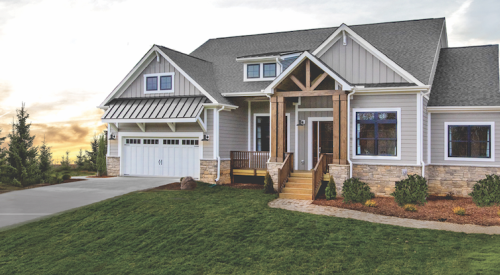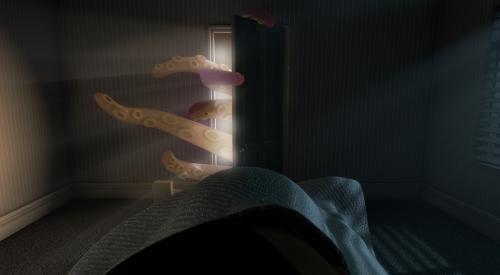Armed with little more than a house plan, half a dozen credit cards, and a dream to break into the home-building business, Paul Schumacher, fresh out of Cornell with absolutely zero home-building experience, set out to create a building company like few others in the nation. It was 1992, and Schumacher had just finished his first real-estate construction project — an urban fixer-upper — and was ready to take on a custom building project.
“It was one of those situations where I had six credit cards and used five of them to pay off the one I used to buy the materials with,” says Schumacher. “I got through it — it almost killed us — but I learned a ton.”
It was during his second custom-home project that Schumacher had an epiphany: Instead of selling each spec home in some phase of construction, why not sell his custom-building services from a well-appointed model home placed in a highly visible location, “sort of like a parade of homes open 365 days a year,” he says. “Once we committed the investment for the first model home, we began geographic expansion with new house plans and designs, and the business took off from there.”
Took off indeed. At a time when most home builders have pulled back on expansion plans, Canton, Ohio-based Schumacher Homes has kept its foot on the accelerator, expanding its build-on-your-lot, custom-home building business into 32 markets, with 30 model homes spread across 14 states. The builder’s aggressive, entrepreneurial spirit has paid off with record sales in 2010 and 2011 (the company is on track to match or surpass last year’s results). And Schumacher is not stopping there — the company has plans to move into several more markets by the end of 2012, all in an effort to achieve its audacious goal of $1 billion in new-home sales in 2016 (the company is well on its way).
Schumacher Homes
Canton, Ohio
Established: 1992
No. of homes built in 2010: 497
Markets served: 32
Notable benchmarks:
VPO review committee — Each week, a VPO review committee examines every variance purchase order submitted that week over $200. This continual-improvement process helps the company keep final construction costs within 1 percent of the original quote.
Real Time Design — Design consultants work with clients to customize their plans on the fly. Clients can request any change to the home design and see the revised design in minutes.
Itemized break down of pricing — Schumacher provides clients with an instant price quote for their project, including cost breakdowns on how their design changes impact the cost of the home.
Companywide scorecard — Each of the company’s 20 locations operates as an individual profit center. The scorecards measure the performance of each office’s sales and production, and are updated in real time. This allows the builder to recognize trends, award accomplishments, and provide action plans for results not meeting goal.
Schumacher’s secret lies in its unique business model, which allows the firm to offer what few competitors can — a custom home at virtually any price range. “What makes us different is that we operate at all price points, from $100,000 to over a million, and we cover a large geographic area,” says Mary Schumacher Becker, VP of sales and marketing. “We don’t really have a national competitor.”
Through the years, the company has mastered its cost structure to ensure that it can offer the best possible value at the lowest possible cost. This includes initiatives like value-engineering plans and taking advantage of the company’s buying power and economies of scale to offer high-quality, brand-name products and systems for buyers at any price range.
“Every single one of our plans is broken down to the last 2x4, square of shingle, etc.,” explains Schumacher. “We know within less than 1 percent variance exactly what that home will cost, so we can be very aggressive on our pricing to the customers because we know our margins. A lot of small builders don’t know their margins until the last check is written and the home is completed to see what’s leftover at the end.”
Having a firm grasp of costs allows the company to build homes that compete price-wise with any comparable home in the market, including existing product. “We know we have to provide a product that is exciting and motivating enough to entice people to buy a new home versus existing,” says Schumacher.
Part of the enticement for customers is being able to customize their home with anything their heart desires — a process that can be as stressful as it is rewarding. To that end, Schumacher has refined its home-buying process to make it fun, fast, and amazingly simple for customers. It’s branded as The Schumacher Way, and includes three steps:
1. Buyers select a plan. As a starting point, clients select from one of more than 200 plans offered in each market. Each plan is designed by a local architect and geared specifically to the regional design trends. “We try to avoid having people come in and have us draw something from scratch — it can be too overwhelming,” says Schumacher, although the builder will take on projects from custom plans.
2. A design consultant works with the buyers to customize the plan. Using a process the company brands as Real-Time Design, a design consultant works with the client to customize their plan on the fly. “The key to our design process is that it’s very simple and extremely fast,” says Schumacher. “They can change anything inside or outside the home and see the adjustments on the screen in seconds.” He says about a third of the company’s clients customize their home to the point where it’s unrecognizable against the original plan.
3. Buyers get an instant, accurate cost estimate. Being able to design on the fly is one thing, but Schumacher also provides clients with an instant price quote for their project, including cost breakdowns on how their design changes impact the cost of the home. The design consultant can take clients through every line item for the project, from framing and foundations to lighting and drywall, and provide a complete project estimate in minutes. “We don’t just say the home is $437,000, we break the costs down to the faucets, lights, flooring, etc.,” says Bill Schumacher, the company’s COO. “What customers appreciate is that they are in complete control of their budget. If they’re over budget, they can forgo, for instance, the 9-foot ceilings at $3,200 in lieu of something that is more important to them. With us, there are no hidden costs or surprises; the process is completely transparent and people appreciate that they know where every dollar is spent.”
How quality gets the job done
Paul Schumacher credits the company’s process for reviewing and acting upon variance purchase orders as key to keeping final construction costs within 1 percent of the original quote — a variance threshold that is almost unheard of in the custom-home market. Each week, a VPO review committee made up of the national operations manager, VP of purchasing, national estimating manager, and national CAD manager reviews every VPO submitted that week over $200. A reason code is assigned to each VPO and specific trade partners are contacted for review. If it is determined that a change in product or design is needed, that change then becomes standard in all of the company’s plans across the 32 markets.
“It’s this continual loop of constant improvement that is our biggest quality measure,” says Paul Schumacher. “It’s painstaking, tedious work, but it’s how we’ve been able to get our variance down under 1 percent across the entire company.”
Having quality management systems and processes in place has also helped the company whittle cycle time down to just 122 days on average across the country. “The first thing customers ask when we start construction is, ‘How soon can we move in?,’” says Schumacher. “They don’t want to wait one or two years for their custom home.”












